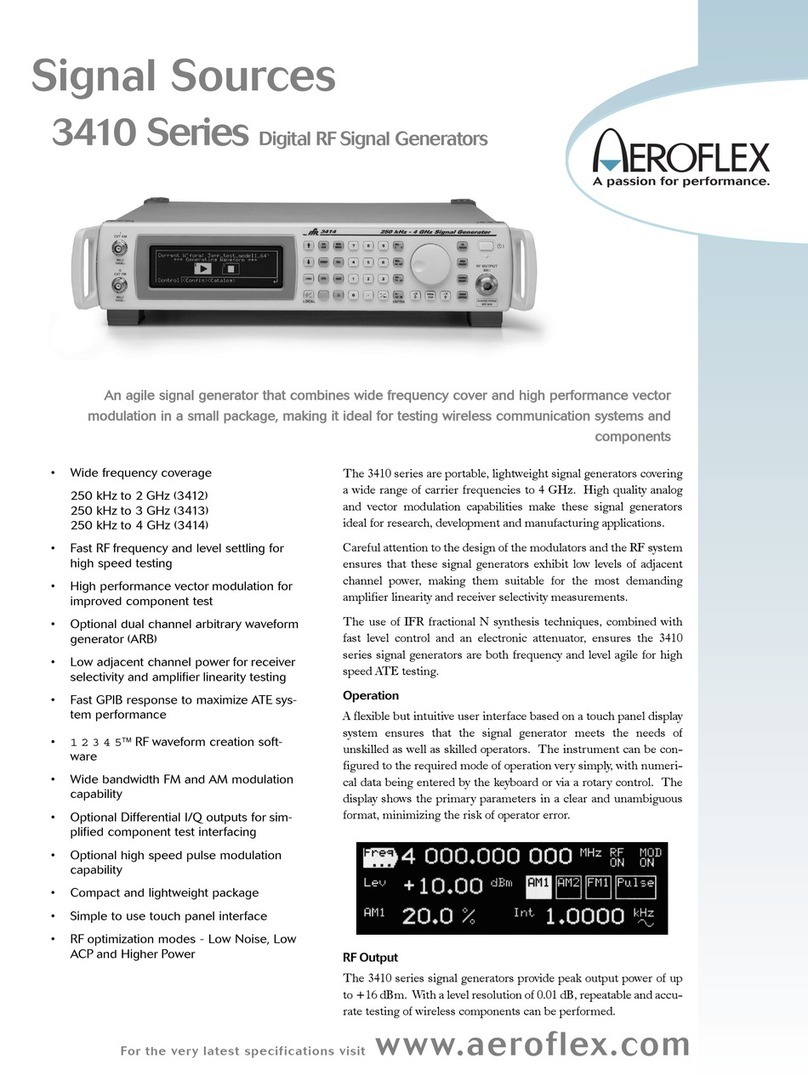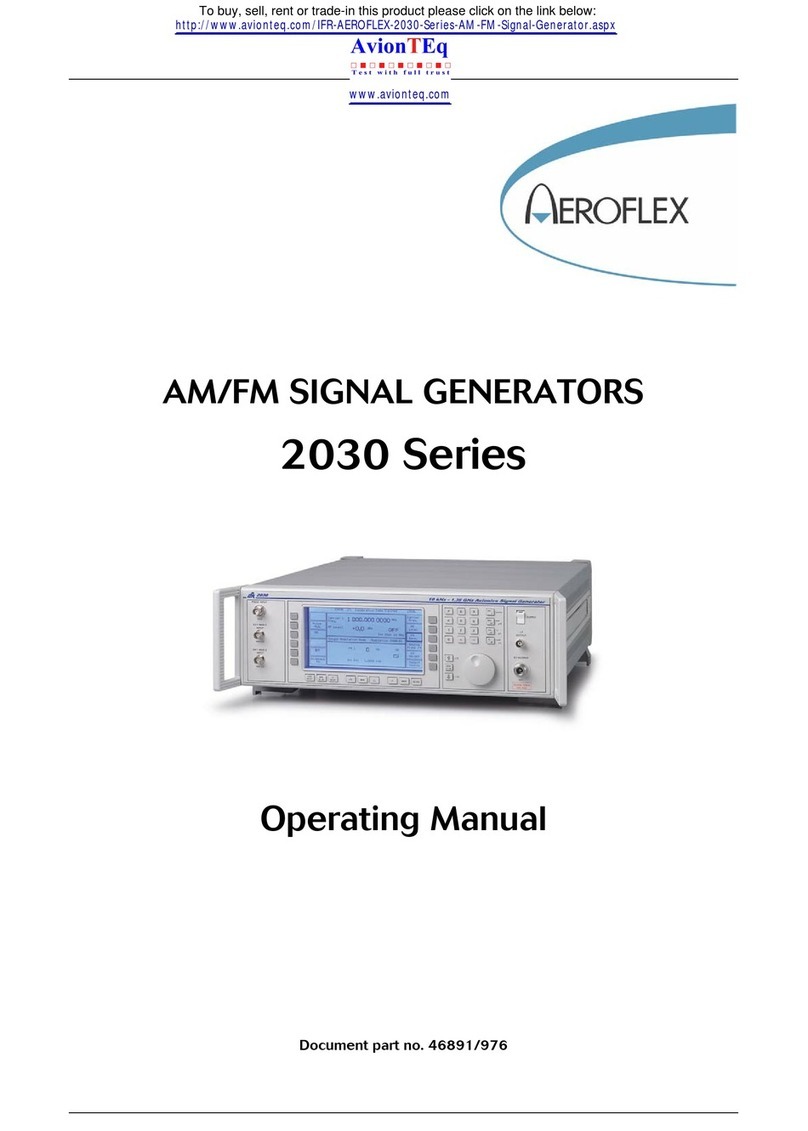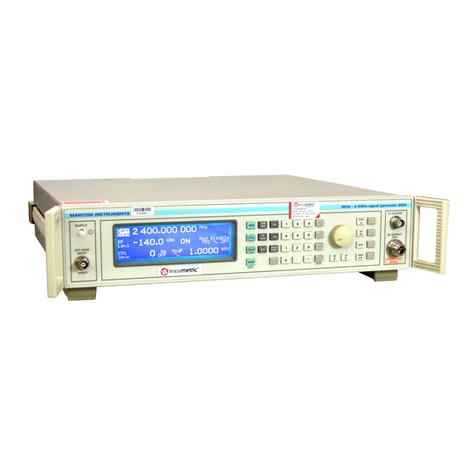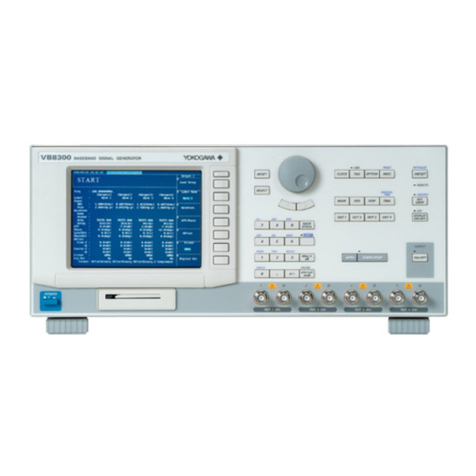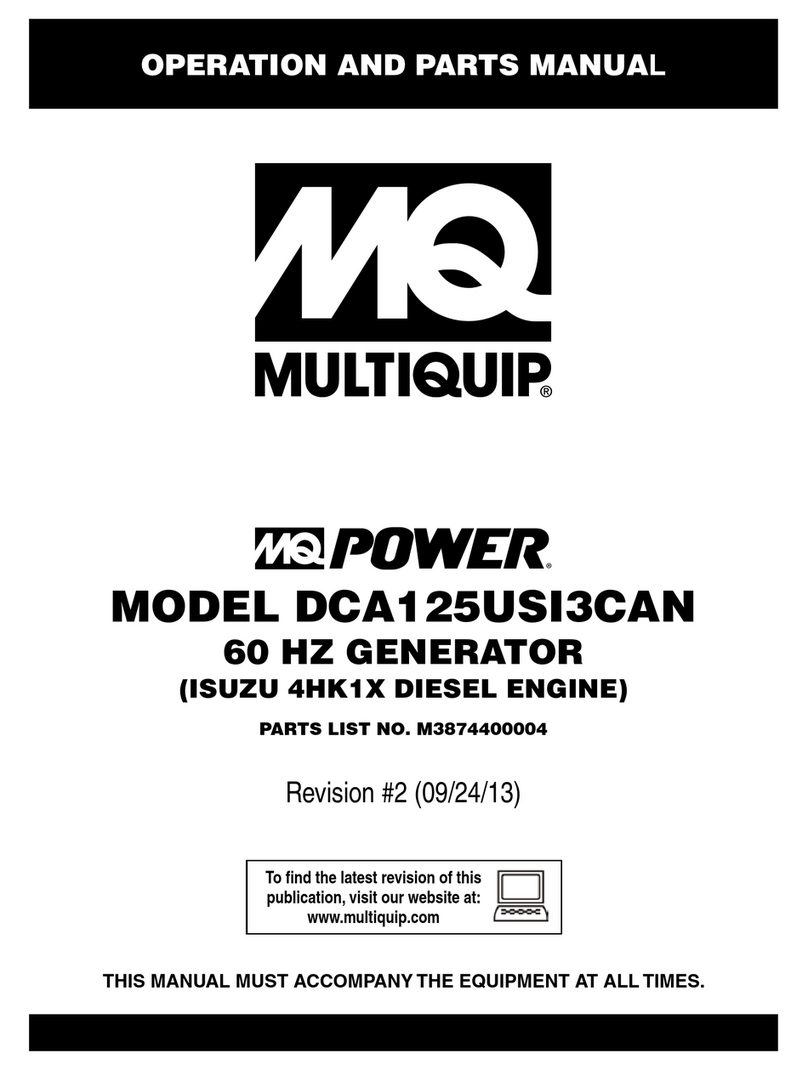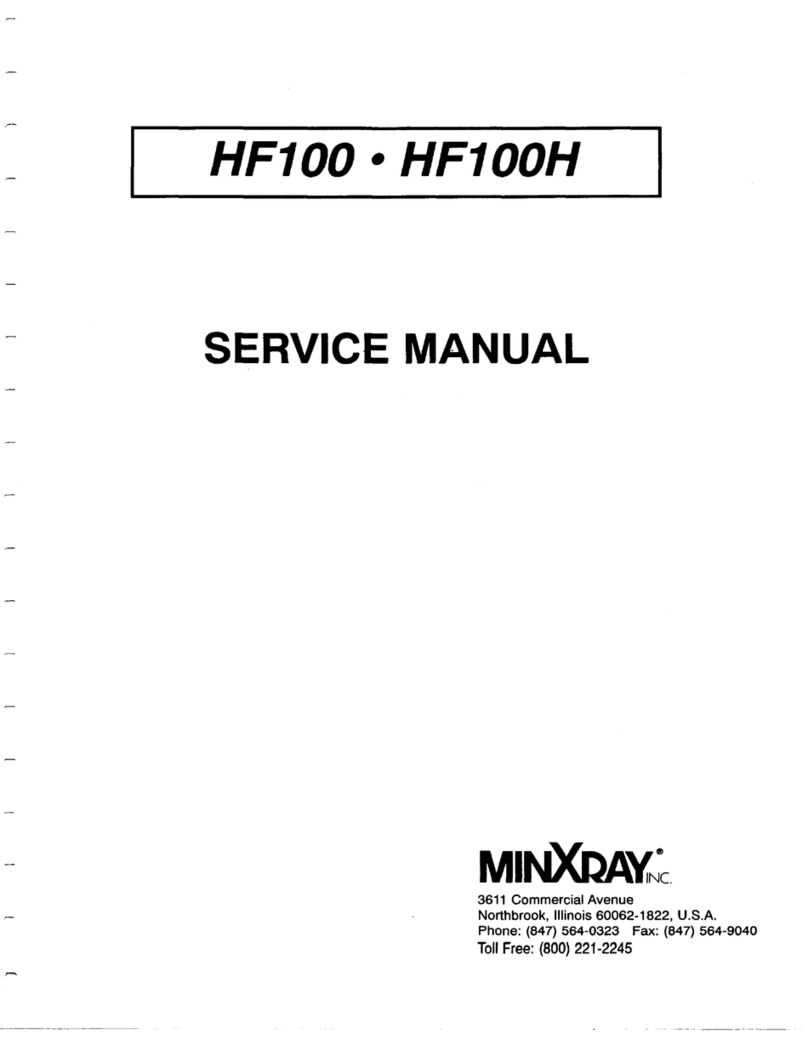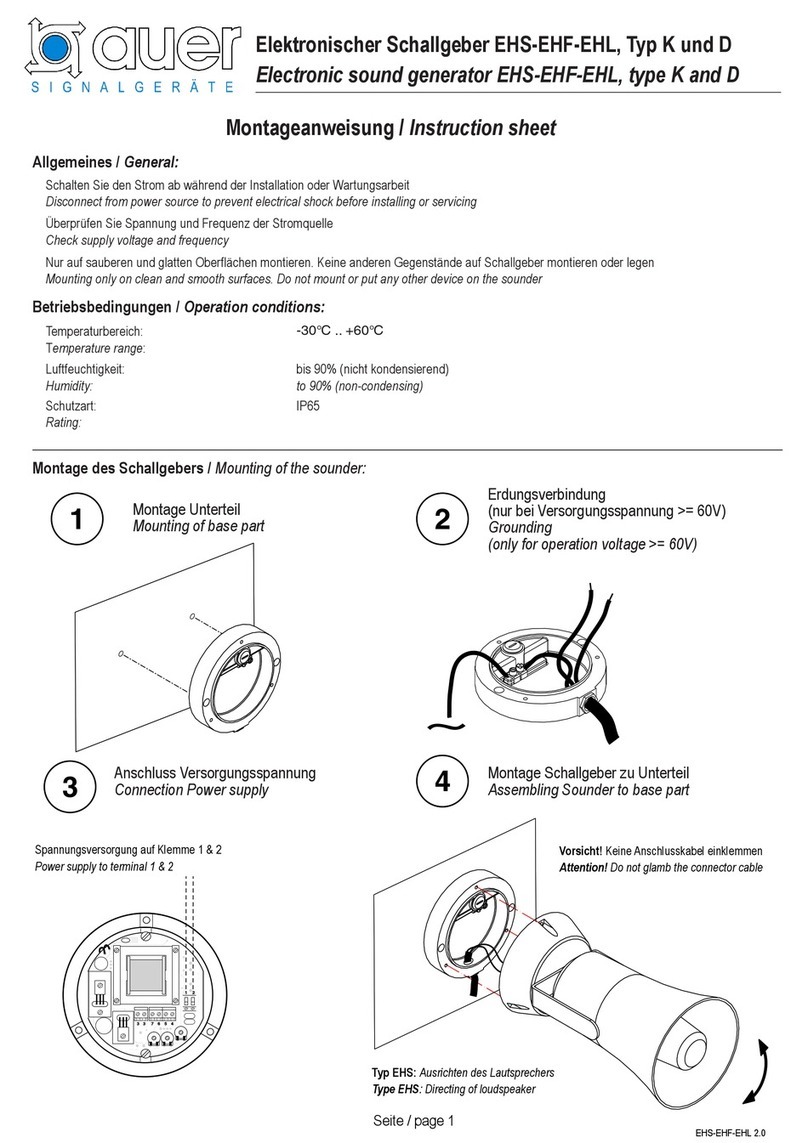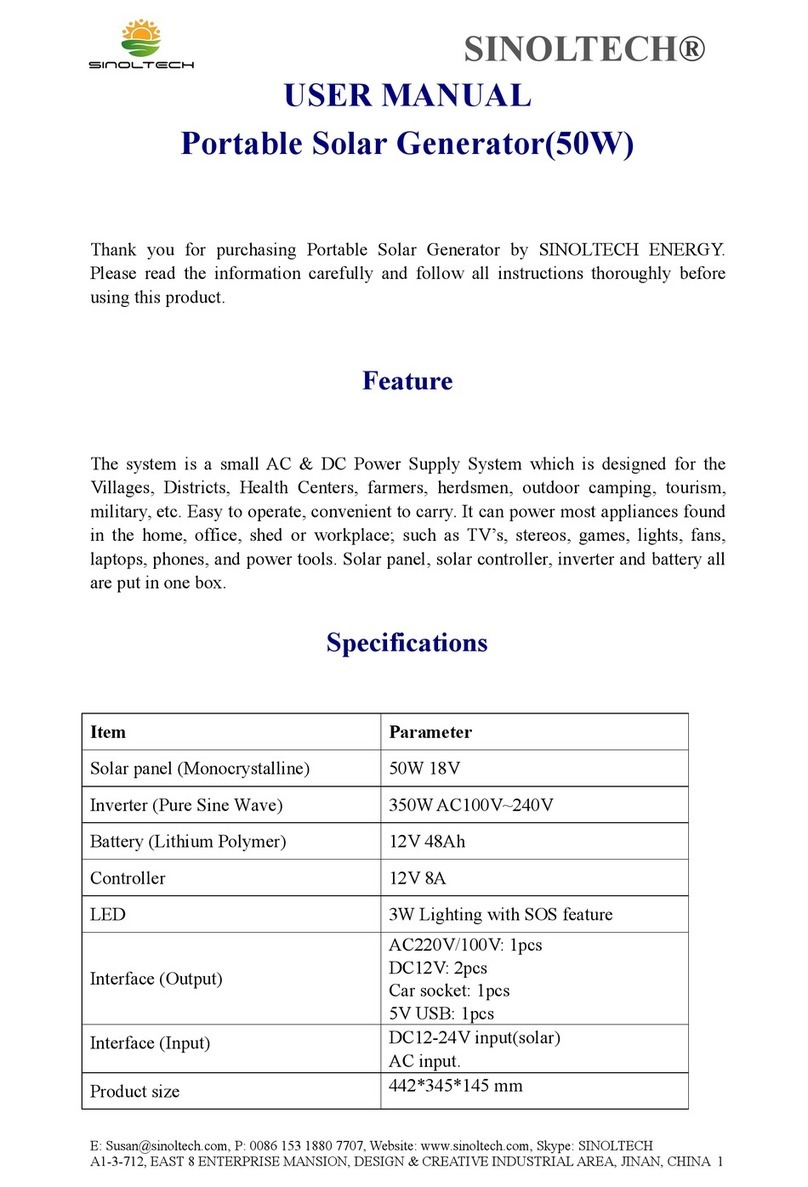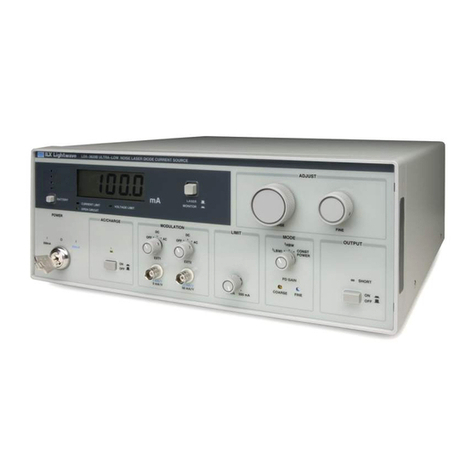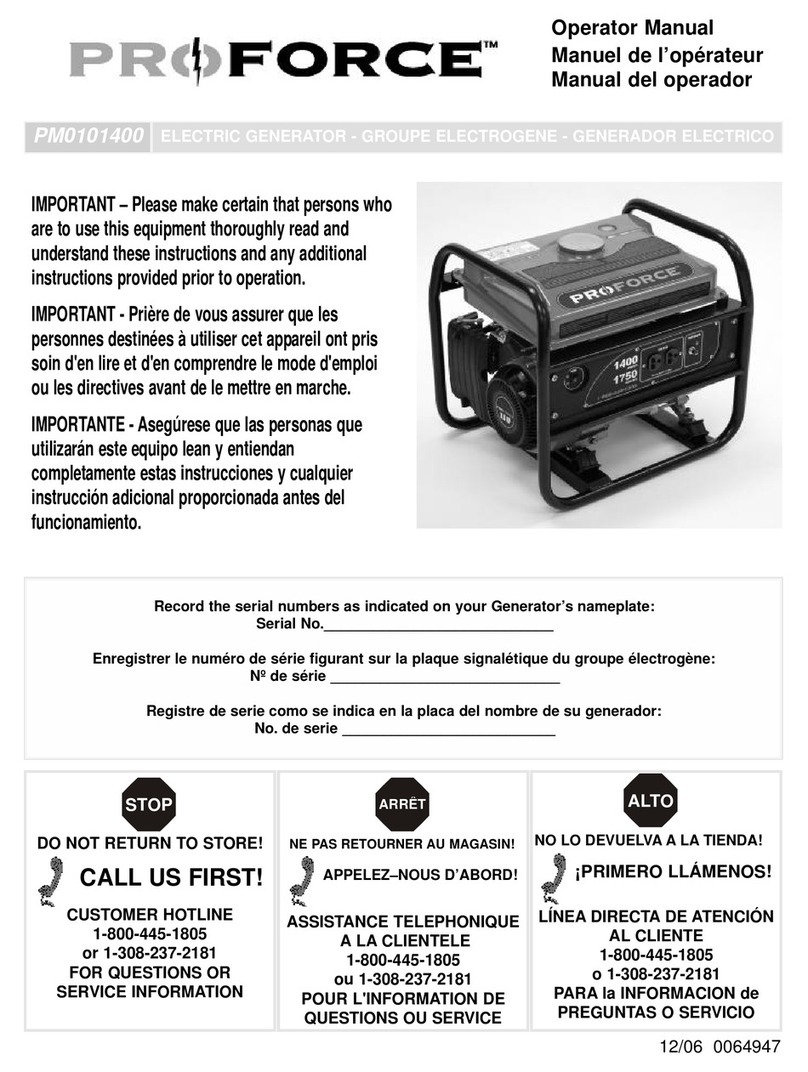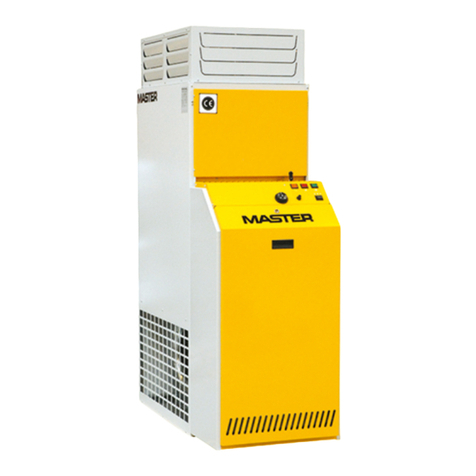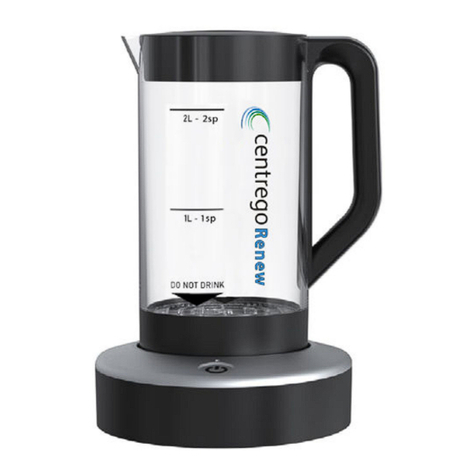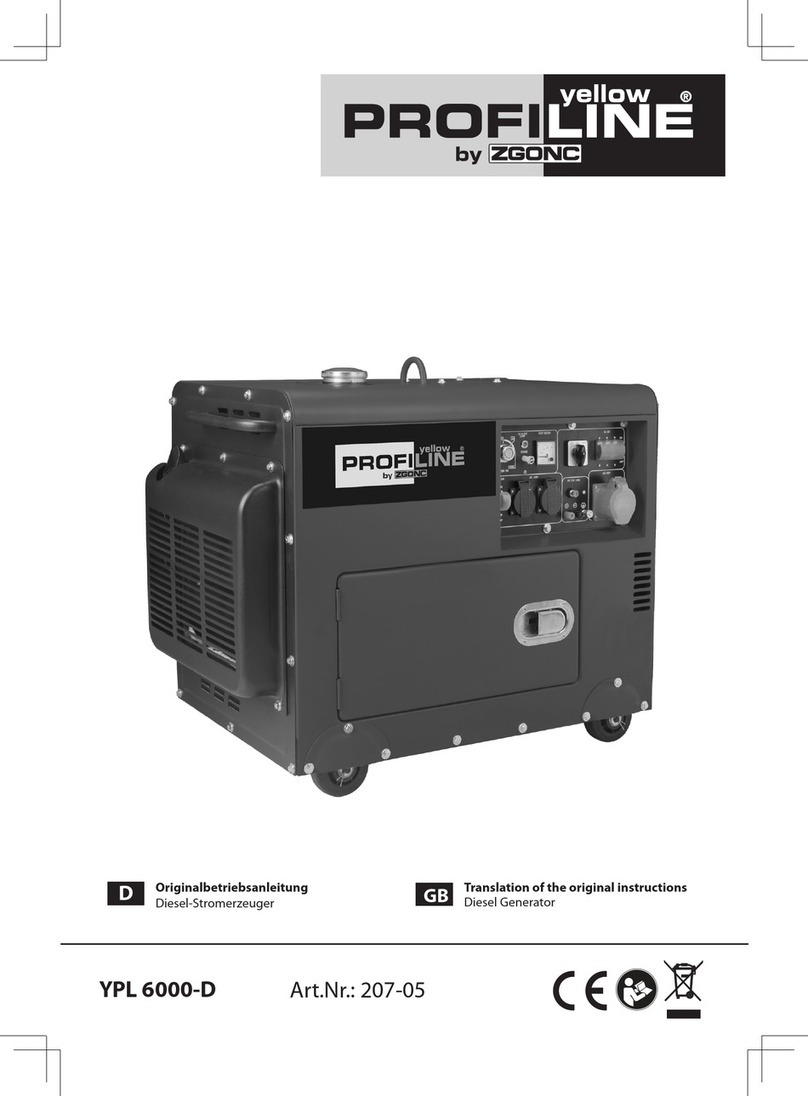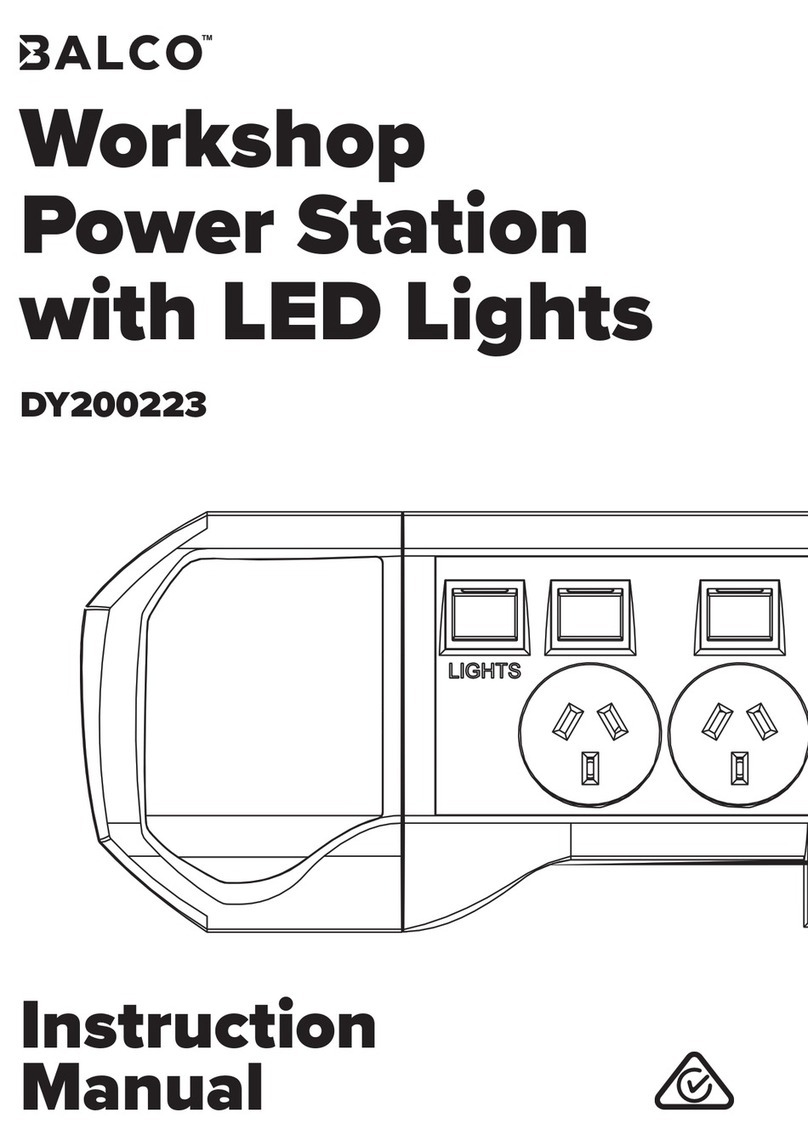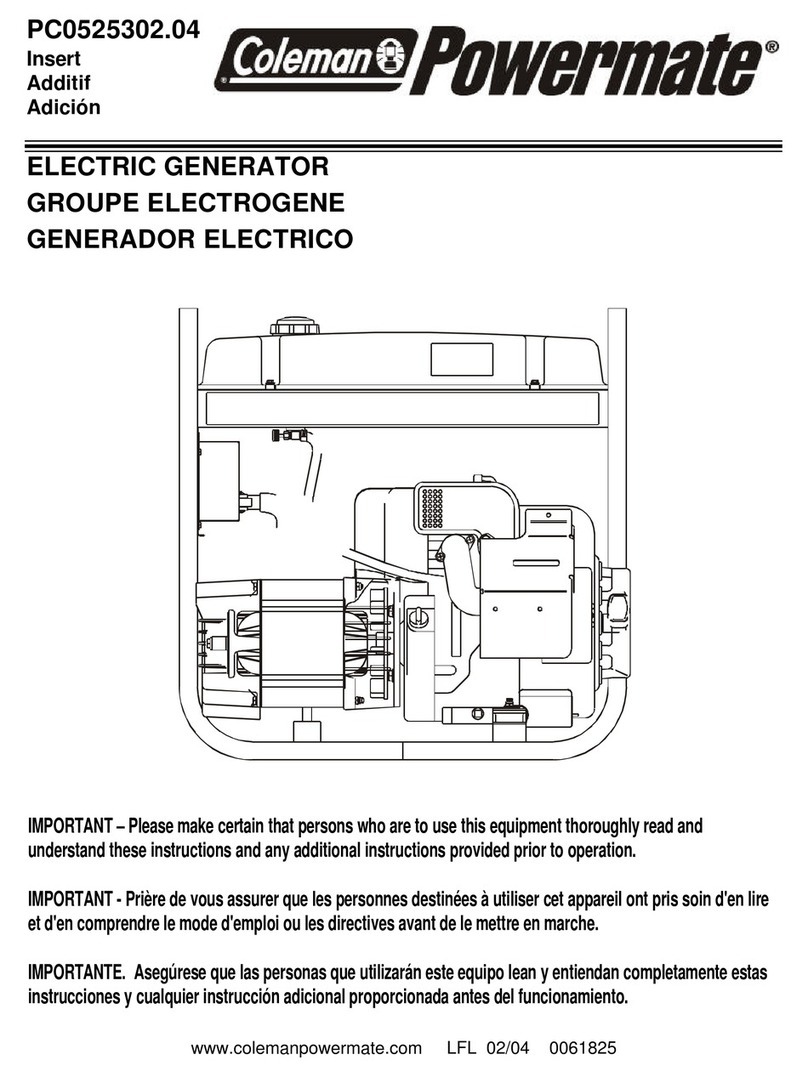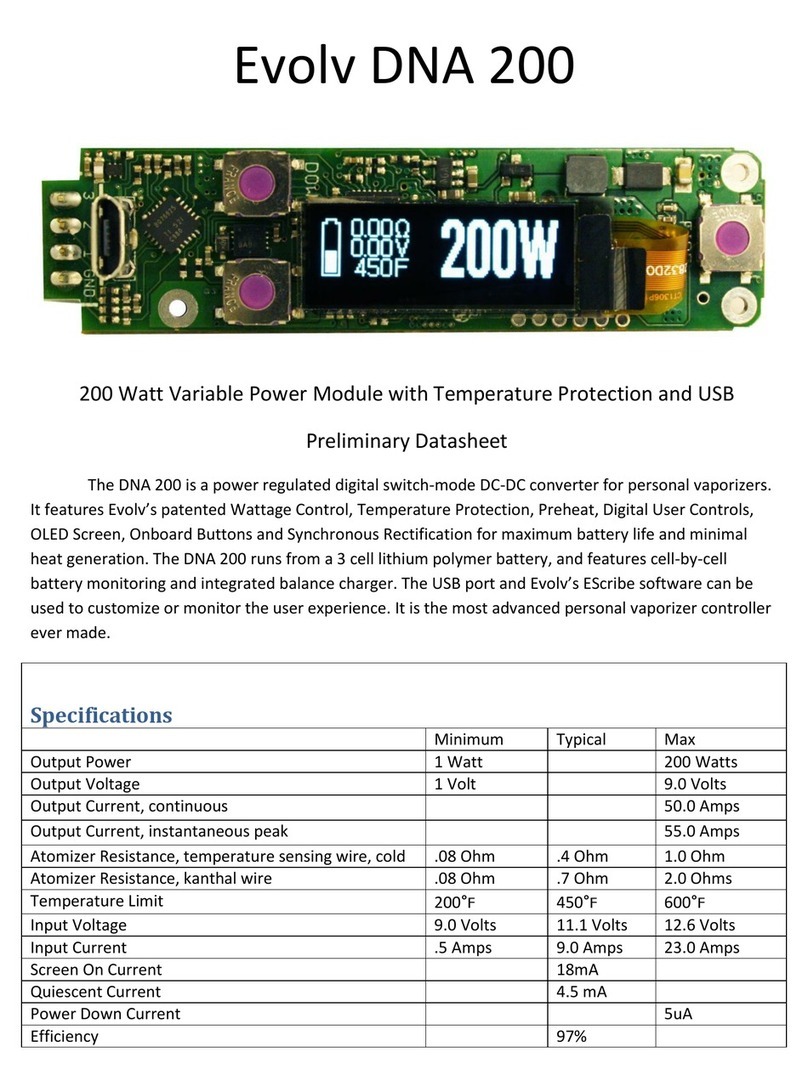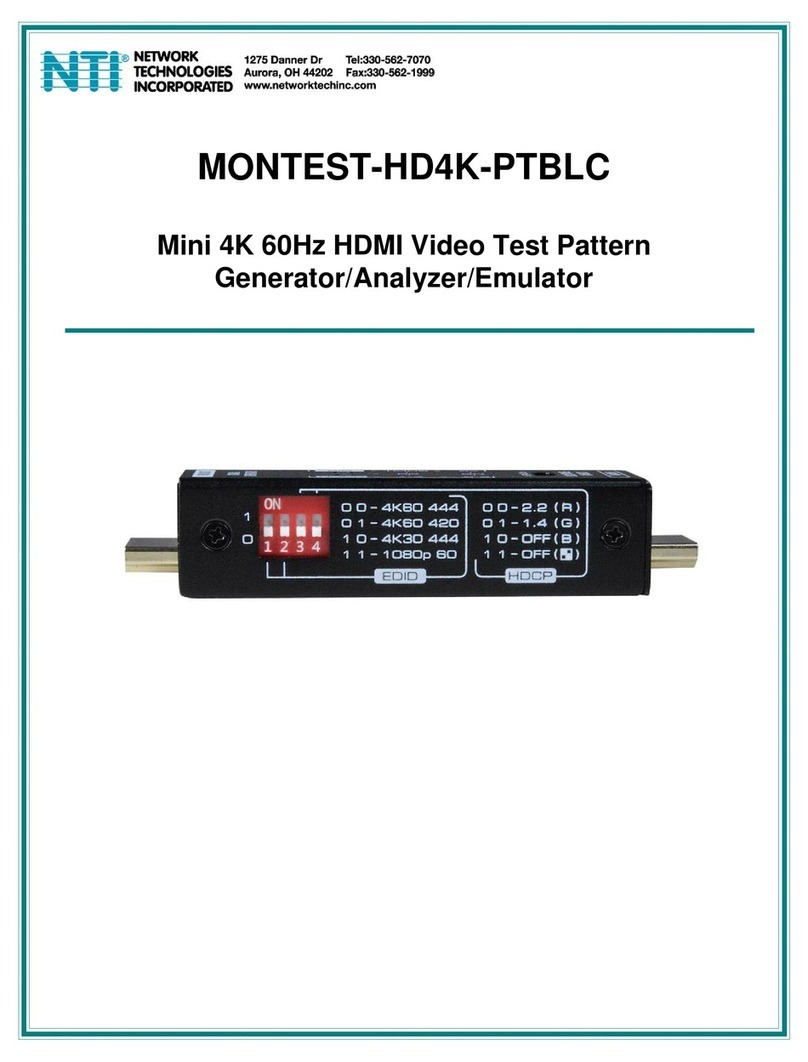Aeroflex NAV-750C User manual

Operating Manual
SIGNAL GENERATOR
NAV-750C
10 kHz to 1.35 GHz
This manual applies to instruments with software issues of 8.09 and higher.
© Aeroflex International Ltd. 2007
No part of this document may be reproduced or transmitted in any form
or by any means, electronic or mechanical, including photocopying,
or recorded by any information storage or retrieval system,
without permission in writing by Aeroflex International Ltd.
(hereafter referred to throughout the document as ‘Aeroflex’).
Document part no. 46892/293 (PDF version)
Based on Issue 8 of the printed manual.
17 May 2007
i

Contents
Tab
numbers
PREFACE
PRECAUTIONS
Chapter 1 GENERAL INFORMATION
Chapter 2 INSTALLATION
Chapter 3-1 OPERATION
Chapter 3-2 GPIB OPERATION
Chapter 4-1 BRIEF TECHNICAL DESCRIPTION
Chapter 5-1 ACCEPTANCE TESTING
App. 5-1-A ACCEPTANCE TESTING SECOND
MODULATION OSCILLATOR OPTION
INDEX
1
2
3
4
5
6
7
8
ii

PREFACE
PATENT PROTECTION
The NAV-750C Signal Generator is protected by the following patents:
GB 2030391
US 4323943
FR 80.26256
GB 2064892
US 4400630
GB 2158999
US 4672336
GB 2217542
US 5061909
EP 0322139
GB 2214012
US 4870384
GB 1601822
US 4194164
EP 0125790
GB 2140232
US 4609881
GB 2258774
US 5375065
iii

Precautions
These terms have specific meanings in this manual:
WARNING
information to prevent personal injury.
information to prevent damage to the equipment.
important general information.
Hazard symbols
The meaning of hazard symbols appearing on the equipment and in the documentation is as
follows:
Symbol Description
Refer to the operating manual when this symbol is marked on
the instrument. Familiarize yourself with the nature of the
hazard and the actions that may have to be taken.
Dangerous voltage
Toxic hazard
General conditions of use
This product is designed and tested to comply with the requirements of IEC/EN61010-1 ‘Safety
requirements for electrical equipment for measurement, control and laboratory use’, for Class I,
portable equipment and is for use in a pollution degree 2 environment. The equipment is designed
to operate from an installation category I and II supply.
Equipment should be protected from the ingress of liquids and precipitation such as rain, snow,
etc. When moving the equipment from a cold to a hot environment, it is important to allow the
temperature of the equipment to stabilize before it is connected to the supply to avoid
condensation forming. The equipment must only be operated within the environmental conditions
specified in Chapter 1 ‘Performance data’ in the Operating manual, otherwise the protection
provided by the equipment may be impaired.
This product is not approved for use in hazardous atmospheres or medical applications. If the
equipment is to be used in a safety-related application, e.g. avionics or military applications, the
suitability of the product must be assessed and approved for use by a competent person.
iv

WARNING
Electrical hazards (AC supply voltage)
This equipment conforms with IEC Safety Class I, meaning that it is provided with a protective
grounding lead. To maintain this protection the supply lead must always be connected to the
source of supply via a socket with a grounded contact.
Be aware that the supply filter contains capacitors that may remain charged after the equipment is
disconnected from the supply. Although the stored energy is within the approved safety
requirements, a slight shock may be felt if the plug pins are touched immediately after removal.
Do not remove instrument covers as this may result in personal injury. There are no user-
serviceable parts inside. Refer all servicing to qualified personnel. See list of Service Centers at
rear of manual.
Fuses
Note that there are supply fuses in both the live and neutral wires of the supply lead. If only one
of these fuses should rupture, certain parts of the equipment could remain at supply potential.
For Option 100, single fuse version only:
Fuses
Note that the internal supply fuse is in series with the live conductor of the supply lead. If
connection is made to a 2-pin unpolarized supply socket, it is possible for the fuse to become
transposed to the neutral conductor, in which case, parts of the equipment could remain at supply
potential even after the fuse has ruptured.
WARNING
Fire hazard
Make sure that only fuses of the correct rating and type are used for replacement.
If an integrally fused plug is used on the supply lead, ensure that the fuse rating is commensurate
with the current requirements of this equipment. See under ‘Performance data’ in Chapter 1 for
power requirements.
WARNING
Toxic hazards
Some of the components used in this equipment may include resins and other materials which give
off toxic fumes if incinerated. Take appropriate precautions, therefore, in the disposal of these
items.
v

WARNING
Beryllia
Beryllia (beryllium oxide) is used in the construction of some of the components in this
equipment.
This material, when in the form of fine dust or vapor and inhaled into the lungs, can cause a
respiratory disease. In its solid form, as used here, it can be handled quite safely although it is
prudent to avoid handling conditions which promote dust formation by surface abrasion.
Because of this hazard, you are advised to be very careful in removing and disposing of these
components. Do not put them in the general industrial or domestic waste or dispatch them by post.
They should be separately and securely packed and clearly identified to show the nature of the
hazard and then disposed of in a safe manner by an authorized toxic waste contractor.
WARNING
Lithium
A Lithium battery (or a Lithium battery contained within an IC) is used in this equipment.
As Lithium is a toxic substance, the battery should in no circumstances be crushed, incinerated or
disposed of in normal waste.
Do not attempt to recharge this type of battery. Do not short circuit or force discharge since this
might cause the battery to vent, overheat or explode.
WARNING
Heavy equipment
The weight of this equipment exceeds the 18 kg (40 lb) guideline for manual handling by a single
person. To avoid the risk of injury, an assessment should be carried out prior to handling which
takes account of the load, workplace environment and individual capability, in accordance with
European Directive 90/269/EEC and associated National Regulations.
WARNING
Tilt facility
When the instrument is in the tilt position, it is advisable, for stability reasons, not to stack other
instruments on top of it.
Pulse input
Before switching the instrument on, ensure that no signal voltage is present on the PULSE INPUT
socket.
vi

Static sensitive components
This equipment contains static sensitive components which may be damaged by handling — refer
to the Maintenance Manual for handling precautions.
Suitability for use
This equipment has been designed and manufactured by Aeroflex to generate low-power RF
signals for testing radio communications apparatus.
If the equipment is not used in a manner specified by Aeroflex, the protection provided by the
equipment may be impaired.
Aeroflex has no control over the use of this equipment and cannot be held responsible for events
arising from its use other than for its intended purpose.
vii

Précautions
Les termes suivants ont, dans ce manuel, des significations particulières:
WARNING
contient des informations pour éviter toute blessure au personnel.
contient des informations pour éviter les dommages aux équipements.
contient d'importantes informations d'ordre général.
Symboles signalant un risque
La signification des symboles de danger apparaissant sur l'équipement et dans la documentation
est la suivante:
Symbole Nature du risque
Reportez-vous au manuel d'utilisation quand ce symbole
apparaît sur l'instrument. Familiarisez-vous avec la nature du
danger et la conduite à tenir.
Tension dangereuse
Danger produits toxiques
Conditions générales d’utilisation
Ce produit a été conçu et testé pour être conforme aux exigences des normes CEI/EN61010-1
“Règles de sécurité pour appareils électriques de mesurage, de régulation et de laboratoire”, pour
des équipements Classe I, portables et pour une utilisation dans un environnement de pollution de
niveau 2. Cet équipement est conçu pour fonctionner à partir d’une alimentation de catégorie I et
II.
Cet équipement doit être protégé de l’introduction de liquides ainsi que des précipitations d’eau,
de neige, etc... Lorsqu’on transporte cet équipement d’un environnement chaud vers un
environnement froid, il est important de laisser l’équipement se stabiliser en température avant de
le connecter à une alimentation afin d’éviter toute formation de condensation. L'appareil doit être
utilisé uniquement dans le cadre des conditions d'environnement spécifiées dans ‘Performance
data’ dans le chapitre 1 du manuel d'utilisation, toute autre utilisation peut endommager les
systèmes de protection.
Ce produit n’est pas garanti pour fonctionner dans des atmosphères dangereuses ou pour un usage
médical. Si l'équipement doit être utilisé pour des applications en relation avec la sécurité, par
exemple des applications militaires ou aéronautiques, la compatibilité du produit doit être établie
et approuvée par une personne compétente.
viii

WARNING
Sécurité électrique (tension d’alimentation alternative)
Cet appareil est protégé conformément à la norme CEI de sécurité Classe 1, c’est-à-dire que sa
prise secteur comporte un fil de protection à la terre. Pour maintenir cette protection, le câble
d’alimentation doit toujours être branché à la source d’alimentation par l’intermédiaire d’une prise
comportant une borne de terre.
Notez que les filtres d’alimentation contiennent des condensateurs qui peuvent encore être chargés
lorsque l’appareil est débranché. Bien que l’énergie contenue soit conforme aux exigences de
sécurité, il est possible de ressentir un léger choc si l’on touche les bornes sitôt après
débranchement.
Ne démontez pas le capot de l'instrument, car ceci peut provoquer des blessures. Il n'y a pas de
pièces remplaçables par l'utilisateur à l'intérieur.
Faites effectuer toute réparation par du personnel qualifié. Contacter un des Centres de
Maintenance Internationaux dans la liste jointe à la fin du manuel.
Fusibles
Notez qu’il y a deux fusibles, l’un pour la phase et l’autre pour le neutre du câble d’alimentation.
Si un seul fusible est coupé, certaines parties de l’appareil peuvent rester au potentiel
d’alimentation.
Option fusible simple
Notez que le fusible d’alimentation interne est en série avec la phase du câble d’alimentation. Si la
prise d’alimentation comporte deux bornes non polarisées, il est possible de connecter le fusible au
neutre. Dans ce cas, certaines parties de l’appareil peuvent rester à un certain potentiel même
après coupure du fusible.
WARNING
!
Risque lie au feu
Lors du remplacement des fusibles vérifiez l'exactitude de leur type et de leur valeur.
Si le cable d'alimentation comporte une prise avec fusible intégré, assurez vous que sa valeur est
compatible avec les besoins en courant de l'appareil. Pour la consommation, reportez vous au
chapitre 1 ‘Performance data’.
WARNING
Danger produits toxiques
Certains composants utilisés dans cet appareil peuvent contenir des résines et d'autres matières qui
dégagent des fumées toxiques lors de leur incinération. Les précautions d'usages doivent donc être
prises lorsqu'on se débarrasse de ce type de composant.
ix

WARNING
Le Beryllia
Le Béryllia (oxyde de Béryllium) entre dans la composition de certains composants de cet
appareil.
Cette matière peut, lorsqu’elle est inhalée sous forme de vapeur ou de fine poussière, être la cause
de maladies respiratoires. Sous sa forme solide, comme c’est le cas ici, cette matière peut être
manipulée sans risque, bien qu’il soit conseillé d’éviter toute manipulation pouvant entraîner la
formation de poussière par abrasion de la surface.
Il est donc conseillé, pour éviter ce risque, de prendre les précautions requises pour retirer ces
composants et s’en débarrasser. Ne les jetez pas avec les déchets industriels ou domestiques ou ne
les envoyez pas par la poste. Il faut les emballer séparément et solidement et bien indiquer la
nature du risque avant de les céder, avec précautions, à une entreprise spécialisée dans le
traitement de déchets toxiques.
WARNING
Lithium
Une pile au Lithium ou un CI contenant une pile au Lithium est utilisé dans cet équipement.
Le Lithium étant une substance toxique, il ne faut en aucun cas l’écraser, l’incinérer ou le jeter
avec des déchets normaux.
N’essayez pas de recharger ce type de pile. Ne court-circuitez pas ou ne forcez pas la décharge de
la pile car cela pourrait causer une fuite, une surchauffe ou une explosion.
WARNING
Equipement lourd
Le poids de cet appareil est supérieur à la limite de 18 kg (40 lb), fixée pour le transport par une
seule personne. Afin d’éviter tout risque de blessure, il est nécessaire de faire, avant le transport,
une évaluation de la charge, des contraintes de l’environnement et des capacités de l’individu, en
conformité avec la Directive Européenne 90/269/EEC ainsi que les recommandations Nationales
concernées.
WARNING
Position inclinée
Lorsque l'appareil est dans une position inclinée, il est recommandé, pour des raisons des stabilité,
de ne pas y empiler d'autres appareils.
x

Utilisation
Cet équipement a été conçu et fabriqué par Aeroflex pour générer des signaux RF de faible
puissance pour le test d'appareils de radio communications.
La protection de l'équipement peut être altérée s'il n'est pas utilisé dans les conditions spécifiées
par Aeroflex. Aeroflex n'a aucun contrôle sur l'usage de l'instrument, et ne pourra être tenu pour
responsable en cas d'événement survenant suite à une utilisation différente de celle prévue.
xi

Vorsichtsmaßnahmen
Diese Hinweise haben eine bestimmte Bedeutung in diesem Handbuch:
WARNING
dienen zur Vermeidung von Verletzungsrisiken.
dienen dem Schutz der Geräte.
enthalten wichtige Informationen.
Gefahrensymbole
Die Bedeutung der Gefahrensymbole auf den Geräten und in der Dokumentation ist wie folgt:
Symbol Gefahrenart
Beziehen Sie sich auf die Bedienungsanleitung wenn das
Messgerät mit diesem Symbol markiert ist. Machen Sie sich
mit der Art der Gefahr und den Aktionen die getroffen
werden müssen bekannt.
Gefährliche Spannung
Warnung vor giftigen Substanzen
Allgemeine Hinweise zur Verwendung
Dieses Produkt wurde entsprechend den Anforderungen von IEC/EN61010-1
“Sicherheitsanforderungen für elektrische Ausrüstung für Meßaufgaben, Steuerung und
Laborbedarf”, Klasse I, transportabel zur Verwendung in einer Grad 2 verunreinigten Umgebung,
entwickelt und getestet. Dieses Gerät ist für Netzversorgung Klasse I und II zugelassen.
Das Gerät sollte vor dem Eindringen von Flüssigkeiten sowie vor Regen, Schnee etc. geschützt
werden. Bei Standortänderung von kalter in wärmere Umgebung sollte das Gerät wegen der
Kondensation erst nach Anpassung an die wärmere Umgebung mit dem Netz verbunden werden.
Das Gerät darf nur in Umgebungsbedingungen wie im Kapitel 1 ‘Leistungsdaten (Performance
data)’ der Bedienungsanleitung beschrieben, betrieben werden; ansonsten wird der vom Gerät
vorgesehene Schutz des Anwenders beeinträchtigt.
Dieses Produkt ist nicht für den Einsatz in gefährlicher Umgebung (z.B. Ex-Bereich) und für
medizinische Anwendungen geprüft. Sollte das Gerät für den Einsatz in sicherheitsrelevanten
Anwendungen wie z.B. im Flugverkehr oder bei militaerischen Anwendungen vorgesehen sein, so
ist dieser von einer für diesen Bereich zuständigen Person zu beurteilen und genehmigen.
xii

WARNING
Elektrische Schläge (Wechselspannungsversorgung)
Das Gerät entspricht IEC Sicherheitsklasse 1 mit einem Schutzleiter nach Erde. Das Netzkabel
muß stets an eine Steckdose mit Erdkontakt angeschlossen werden.
Filterkondensatoren in der internen Spannungsversorgung können auch nach Unterbrechung der
Spannungszuführung noch geladen sein. Obwohl die darin gespeicherte Energie innerhalb der
Sicherheitsmargen liegt, kann ein leichter Spannungsschlag bei Berührung kurz nach der
Unterbrechung erfolgen.
Öffnen Sie niemals das Gehäuse der Geräte das dies zu ernsthaften Verletzungen führen kann. Es
gibt keine vom Anwender austauschbare Teile in diesem Gerät.
Lassen Sie alle Reparaturen durch qualifiziertes Personal durchführen. Eine Liste der
Servicestellen finden Sie auf der Rückseite des Handbuches.
Sicherungen
Es ist zu beachten, daß es Sicherungen in beiden (spannunsführenden und neutralen) Zuleitungen
gibt. Wenn nur eine von diesen Sicherungen schmilzt, so bleiben einige Geräteteile immer noch
auf Spannungspotential.
Einsicherungs-Option
Die interne Sicherung in der Spannungszuführung ist in Reihe mit der spannungsführenden
Zuleitung geschaltet. Bei Verbindung mit einer zweiadrigen, nicht gepolten Steckdose kann die
Sicherung in der Masseleitung liegen, so daß auch bei geschmolzener Sicherung Geräteteile immer
noch auf Spannungspotential sind.
WARNING
Feuergefahr
Es dürfen nur Ersatzsicherungen vom gleichen Typ mit den korrekten Spezifikationen
entsprechend der Stromaufnahme des Gerätes verwendet werden. Siehe hierzu die Leistungsdaten
(‘Performance data’ in Kapitel 1.
WARNING
Warnung vor giftigen Substanzen
In einigen Bauelementen dieses Geräts können Epoxyharze oder andere Materialien enthalten sein,
die im Brandfall giftige Gase erzeugen. Bei der Entsorgung müssen deshalb entsprechende
Vorsichtsmaßnahmen getroffen werden.
xiii

WARNING
Beryllium Oxid
Beryllium Oxid wird in einigen Bauelementen verwendet.
Als Staub inhaliert kann Beryllium zu Schädigungen der Atemwege führen. In fester Form kann
es ohne Gefahr gehandhabt werden, wobei Staubabrieb vermieden werden sollte.
Wegen dieser Gefahren dürfen diese Bauelemente nur mit der entsprechenden Vorsicht ausgebaut
und entsorgt werden. Sie dürfen nicht mit Industrie oder Hausmüll vermengt oder per Post
versandt werden. Sie müssen separat verpackt und entsprechend der Gefährdung markiert werden.
Die Entsorgung muß über einen autorisierten Fachbetrieb erfolgen.
WARNING
Lithium
Eine Lithium Batterie oder eine Lithium Batterie innerhalb eines IC ist in diesem Gerät eingebaut.
Da Lithium ein giftiges Material ist, sollte es als Sondermüll entsorgt werden.
Diese Batterie darf auf keinen Fall geladen werden. Nicht kurzschließen, da sie dabei überhitzt
werden und explodieren kann.
WARNING
Schweres Gerät
Das Gewicht dieses Geräts liegt über der 18 kg (40 lb) Grenze für Transport durch eine einzelne
Person. Zur Vermeidung von Verletzungen sollten vor einem Transport die Arbeitsumgebung und
die persönlichen Möglichkeiten im Verhältnis zur Last abgewogen werden, wie in der EU-
Regelung 90/269/EEC und nationalen Normen beschrieben.
WARNING
Schrägstellung
Bei Schrägstellung des Geräts sollten aus Stabilitätsgründen keine anderen Geräte darauf gestellt
werden.
xiv

Eignung für Gebrauch
Dieses Gerät wurde von Aeroflex entwickelt und hergestellt um HF Signale geringer Leistung zum
Test von Kommunikationseinrichtungen zu erzeugen.
Sollte das Gerät nicht auf die von Aeroflex vorgesehene Art und Weise verwendet werden, kann
die Schutzfunktion des Gerätes beeinträchtigt werden.
Aeroflex hat keinen Einfluß auf die Art der Verwendung und übernimmt keinerlei Verantwortung
bei unsachgemässer Handhabung.
xv

Precauzioni
Questi termini vengono utilizzati in questo manuale con significati specifici:
WARNING
riportano informazioni atte ad evitare possibili pericoli alla persona.
riportano informazioni per evitare possibili pericoli all'apparecchiatura.
riportano importanti informazioni di carattere generale.
Simboli di pericolo
Il significato del simbolo di pericolo riportato sugli strumenti e nella documentazione è il
seguente:
Simbolo Tipo di pericolo
Fare riferimento al manuale operativo quando questo
simbolo è riportato sullo strumento. Rendervi conto della
natura del pericolo e delle precauzioni che dovrete prendere.
Tensione pericolosa
Pericolo sostanze tossiche
Condizioni generali d’uso
Questo prodotto è stato progettato e collaudato per rispondere ai requisiti della direttiva
IEC/EN61010-1 ‘Safety requirements for electrical equipment for measurement, control and
laboratory use’ per apparati di classe I, trasportabili e per l’uso in un ambiente inquinato di grado
2. L’apparato è stato progettato per essere alimentato da un alimentatore di categoria I e II.
Lo strumento deve essere protetto dal possibile ingresso di liquidi quali, ad es., acqua, pioggia,
neve, ecc. Qualora lo strumento venga portato da un ambiente freddo ad uno caldo, è importante
lasciare che la temperatura all’interno dello strumento si stabilizzi prima di alimentarlo per evitare
formazione di condense. Lo strumento deve essere utilizzato esclusivamente nelle condizioni
ambientali descritte nel capitolo 1 ‘Performance data’ del manuale operativo, in caso contrario le
protezioni previste nello strumento potrebbero risultare non sufficienti.
Questo prodotto non è stato approvato per essere usato in ambienti pericolosi o applicazioni
medicali. Se lo strumento deve essere usato per applicazioni particolari collegate alla sicurezza
(per esempio applicazioni militari o avioniche), occorre che una persona o un istituto competente
ne certifichi l'uso.
xvi

WARNING
Pericoli da elettricità (alimentazione c.a.)
Quest ’apparato è provvisto del collegamento di protezione di terra e rispetta le norme di sicurezza
IEC, classe 1. Per mantenere questa protezione è necessario che il cavo, la spina e la presa
d’alimentazione siano tutti provvisti di terra.
Il circuito d’alimentazione contiene dei filtri i cui condensatori possono restare carichi anche dopo
aver rimosso l’alimentazione. Sebbene l’energia immagazzinata è entro i limiti di sicurezza,
purtuttavia una leggera scossa può essere avvertita toccando i capi della spina subito dopo averla
rimossa.
Non rimuovete mai le coperture perché così potreste provocare danni a voi stessi. Non vi sono
all’interno parti di interesse all’utilizzatore.
Tutte gli interventi sono di competenza del personale qualificato. Vedi elenco internazionale dei
Centri di Assistenza in fondo al manuale.
Fusibili
Notare che entrambi i capi del cavo d’alimentazione sono provvisti di fusibili. In caso di rottura di
uno solo dei due fusibili, alcune parti dello strumento potrebbero restare sotto tensione.
Opzione singolo fusibile
Notare che un fusibile è posto sul filo caldo del cavo di alimentazione. Qualora l’alimentazione
avvenga tramite due poli non polarizzati, è possibile che il fusibile vada a protezione del neutro
per cui anche in caso di una sua rottura, l’apparato potrebbe restare sotto tensione.
WARNING
Pericolo d'incendio
Assicurarsi che, in caso di sostituzione, vengano utilizzati solo fusibili della portata e del tipo
prescritti.
Se viene usata una spina con fusibili, assicurarsi che questi siano di portata adeguata ai requisiti di
alimentazione richiesti dallo strumento. Tali requisiti sono riportati nel capitolo1 ‘Performance
data’.
WARNING
Pericolo sostanze tossiche
Alcuni dei componenti usati in questo strumento possono contenere resine o altri materiali che, se
bruciati, possono emettere fumi tossici. Prendere quindi le opportune precauzioni nell'uso di tali
parti.
xvii

WARNING
Berillio
Berillio (ossido di berillio) è utilizzato nella costruzione di alcuni componenti di quest’apparato.
Questo materiale, se inalato sotto forma di polvere fine o vapore, può causare malattie respiratorie.
Allo stato solido, come è usato qui, può essere maneggiato con sufficiente sicurezza anche se è
prudente evitare condizioni che provochino la formazione di polveri tramite abrasioni superficiali.
A cause di questi pericoli occorre essere molto prudenti nella rimozione e nella locazione di questi
componenti. Questi non devono essere gettati tra i rifiuti domestici o industriali né. vanno spediti
per posta. Essi devono essere impacchettati separatamente ed in modo sicuro e devono indicare
chiaramente la natura del pericolo e quindi affidate a personale autorizzato.
WARNING
Litio
Quest ’apparato incorpora una batteria al litio o un circuito integrato contenente una batteria al
litio.
Poiché il litio è una sostanza tossica, la batteria non deve essere mai né rotta, né incenerita, né
gettata tra i normali rifiuti.
Questo tipo di batteria non può essere sottoposto né a ricarica né a corto-circuito o scarica forzata.
Queste azioni possono provocare surriscaldamento, fuoriuscita di gas o esplosione della batteria.
WARNING
Instrumento pesado
El peso de este equipo excede de los 18 kg (40 lb), lo que debe tenerse en cuenta si va ser
transportado manualmente por una sola persona. Para evitar el riesgo de lesiones, antes de mover
el equipo deberá evaluar la carga, el entorno de trabajo y la propia capacidad, de acuerdo con la
Directiva Europea 90/269/EEC y el Reglamento Nacional Asociado.
WARNING
Posizionamento inclinato
Quando lo strumento è in posizione inclinata è raccomandato, per motivi di stabilità, non
sovrapporre altri strumenti.
Caratteristiche d’uso
Questo strumento è stato progettato e prodotto da Aeroflex generare segnali RF in bassa potenza
per provare apparati di radio comunicazione.
xviii

Se lo strumento non è utilizzato nel modo specificato da Aeroflex, le protezioni previste sullo
strumento potrebbero risultare inefficaci.
Aeroflex non può avere il controllo sull’uso di questo strumento e non può essere ritenuta
responsabile per eventi risultanti da un uso diverso dallo scopo prefisso.
xix
This manual suits for next models
1
Table of contents
Other Aeroflex Portable Generator manuals

